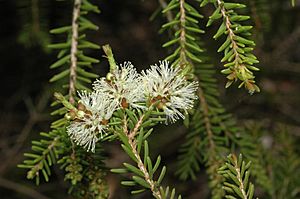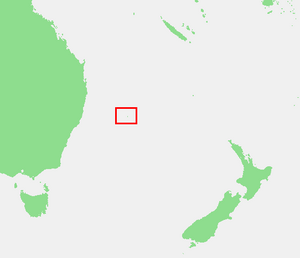Lord Howe Island tea tree facts for kids
Quick facts for kids Lord Howe Island tea tree |
|
|---|---|
 |
|
| Scientific classification | |
| Genus: |
Melaleuca
|
| Species: |
howeana
|
 |
|
| M. howeana is endemic to Lord Howe Island | |
The Lord Howe Island tea tree (Melaleuca howeana) is a special plant. It belongs to the myrtle family, called Myrtaceae. This tea tree is found only on the Lord Howe Island group. This island group is about 600 kilometers (370 miles) off the east coast of Australia.
You can often see this plant in windy places. It grows on cliffs and ridges. Sometimes, it even forms large groups of just tea trees. Its closest relative on the mainland is the Melaleuca ericifolia.
Contents
What Does the Lord Howe Island Tea Tree Look Like?
The Lord Howe Island tea tree is a thick, bushy plant. It can grow to be about 3 to 4 meters (10 to 13 feet) tall. It has bark that peels off in flakes.
When the branches are young, they have soft, silky hairs. As they get older, these hairs disappear. The leaves grow in a pattern, usually one after another. Sometimes, they grow in groups of three. Each leaf is small, about 3 to 9 millimeters (0.1 to 0.4 inches) long. They are narrow and have a rounded tip.

Flowers and Fruit
The flowers of the Lord Howe Island tea tree are white. They grow in spikes at the ends of the branches. These spikes are about 20 millimeters (0.8 inches) wide. Each spike has between 6 and 18 individual flowers.
The petals are small, about 1.5 to 2 millimeters (0.06 to 0.08 inches) long. They fall off as the flower gets older. Inside the flower, there are five groups of stamens. Stamens are the parts that make pollen. Each group has 6 to 12 stamens.
The tea tree blooms from mid-September to December. After the flowers, the plant grows small, woody fruits. These fruits are shaped like cups and are about 3 to 4 millimeters (0.1 to 0.2 inches) long.
Where Does the Lord Howe Island Tea Tree Live?
The Lord Howe Island tea tree grows on Lord Howe Island itself. It is also found on a very tall rock called Ball's Pyramid. This plant is very common, especially near the ocean. It likes places where salt spray from the sea can reach it, like on beaches and sea cliffs. You can also find it on ridges further inland.
The Tea Tree's Role in Nature
The Lord Howe Island tea tree is very important for a special insect. It provides a home for the Lord Howe Island stick insect (Dryococelus australis). This stick insect is a critically endangered species. This means it is very close to disappearing forever.
On Ball's Pyramid, one tea tree grows in a small crack in the rocks. Water seeps through these cracks, helping the plant grow well. This creates a thick layer of plant material on the ground. The stick insects live in this plant debris. Scientists have bred these insects in special programs. They have now been returned to Lord Howe Island to help their numbers grow.

